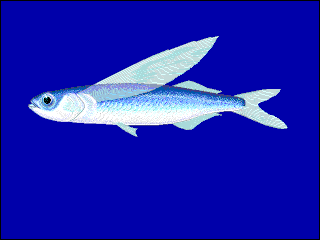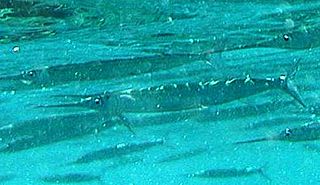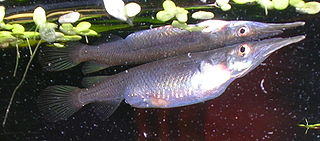Hemiramphidae is a family of fishes that are commonly called halfbeaks, spipe fish or spipefish. They are a geographically widespread and numerically abundant family of epipelagic fish inhabiting warm waters around the world. The halfbeaks are named for their distinctive jaws, in which the lower jaws are significantly longer than the upper jaws. The similar viviparous halfbeaks have often been included in this family.

Beloniformes is an order composed of six families of freshwater and marine ray-finned fish:
The ballyhoo halfbeak or ballyhoo is a baitfish of the halfbeak family (Hemiramphidae). It is similar to the Balao halfbeak in most features. Ballyhoo are frequently used as cut bait and for trolling purposes by saltwater sportsmen. The fish is reported to have caused ciguatera poisoning in humans.

Hemiramphus is a genus of schooling marine fish commonly called halfbeaks, garfish, or ballyhoos, and are members of the family Hemiramphidae. They inhabit the surface of warm temperate and tropical sea, and feed on algae, plankton, and smaller fish. Hemiramphus species are edible but are more important as food fish for larger predatory species including dolphinfish and billfish.

Dermogenys is a genus of viviparous halfbeaks. They are widely distributed in fresh and brackish water in South and Southeast Asia, ranging from India to the Philippines and Greater Sundas. They are all viviparous, producing small clutches of up to 30 fry that closely resemble the adults, except they are much smaller, around 1–1.5 cm (0.4–0.6 in) in length. Adults are typically around 6–7 cm (2.4–2.8 in) in length, with females being slightly larger than males. Males tend to be more brightly coloured and are well known for being aggressive towards one another. The wrestling halfbeak, D. pusilla, is widely used in Asia as fighting animals upon which wagers are placed. Both sexes have lower jaws (mandibles) that are much longer than the upper ones, and from this comes the "halfbeak" name.
Chriodorus atherinoides is a species of halfbeak found in coastal waters of the western Atlantic Ocean from southern United States to Mexico including Cuba and the Bahamas. This species is euryhaline and frequently migrates up rivers. It is of no commercial value. Unlike most other halfbeaks, the upper and lower jaws are of a similar size.

Hemirhamphodon is a genus of viviparous halfbeak fish. Most recognized species are endemic to lowland forest streams, rivers and swamps in Borneo, but H. phaiosoma and H. pogonognathus are also found elsewhere in Southeast Asia. The largest species reaches about 10 cm (4 in) in length. These fish are viviparous and are sometimes kept as aquarium fish, but otherwise have no commercial value.

Zenarchopterus is a genus of viviparous halfbeaks. These fish are found in marine, brackish and fresh water of the Indo-Pacific region. Despite being in the viviparous halfbeak family, Zenarchopterus species are oviparous.

Euleptorhamphus is a genus of halfbeaks in the order Beloniformes.

The Balao halfbeak, occasionally called the Balao for short, is an ocean-going species of fish in the family Hemiramphidae. It was first described by the French naturalist Charles Alexandre Lesueur in 1821. They are used as cut bait and for trolling purposes by saltwater sportsmen.

Hyporhamphus is a genus of halfbeaks. The species in this genus are distributed throughout the warmer seas of the world, most species being Indo-Pacific and there are some freshwater species.
Rhynchorhamphus arabicus or Arabian flyingfish is a halfbeak of the family Hemiramphidae of the order Beloniformes.
Rhynchorhamphus georgii or long-billed halfbeak is a halfbeak of the family Hemiramphidae of the order Beloniformes.
Rhynchorhamphus malabaricus or Malabar halfbeak is a halfbeak of the family Hemiramphidae of the order Beloniformes.
Rhynchorhamphus naga is a halfbeak of the family Hemiramphidae of the order Beloniformes.

The American halfbeak, also known as Meek's halfbeak, is a halfbeak from the family Hemiramphidae.
Hyporhamphus collettei is a halfbeak from the family Hemiramphidae.
The black-tipped halfbeak, Hyporhamphus neglectissimus, is a halfbeak from the family Hemiramphidae.

Zenarchopteridae, the viviparous halfbeaks, is a family in the order Beloniformes. The Zenarchopteridae exhibit strong sexual dimorphism, practicing internal fertilisation, and in some cases ovoviviparous or viviparous. The members in the family are mainly found in fresh and brackish water of tropical Asia and New Guinea, but the genus Zenarchopterus also includes marine species from the Indo-Pacific. Several, such as the wrestling halfbeak, have become commonly traded aquarium fish.
The Longfin halfbeak is an ocean-going species of fish in the family Hemiramphidae native to the eastern Pacific Ocean.







